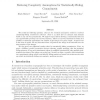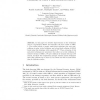EUROCRYPT
2005
Springer
14 years 5 months ago
2005
Springer
We revisit the following question: what are the minimal assumptions needed to construct statistically-hiding commitment schemes? Naor et al. show how to construct such schemes bas...
EUROCRYPT
2005
Springer
14 years 5 months ago
2005
Springer
We present several attacks on RSA that factor the modulus in polynomial time under the condition that a fraction of the most significant bits or least significant bits of the pri...
EUROCRYPT
2005
Springer
14 years 5 months ago
2005
Springer
Traitor tracing schemes are of major importance for secure distribution of digital content. They indeed aim at protecting content providers from colluding users to build pirate dec...
EUROCRYPT
2005
Springer
14 years 5 months ago
2005
Springer
It is a standard result in the theory of quantum error-correcting codes that no code of length n can fix more than n/4 arbitrary errors, regardless of the dimension of the coding ...
EUROCRYPT
2005
Springer
14 years 5 months ago
2005
Springer
Abstract. We propose and realize a definition of security for passwordbased key exchange within the framework of universally composable (UC) security, thus providing security guar...
EUROCRYPT
2005
Springer
14 years 5 months ago
2005
Springer
We introduce a new flavor of commitment schemes, which we call mercurial commitments. Informally, mercurial commitments are standard commitments that have been extended to allow ...
EUROCRYPT
2005
Springer
14 years 5 months ago
2005
Springer
Biometric data offer a potential source of high-entropy, secret information that can be used in cryptographic protocols provided two issues are addressed: (1) biometric data are n...
EUROCRYPT
2005
Springer
14 years 5 months ago
2005
Springer
This paper introduces the related-key boomerang and the related-key rectangle attacks. These new attacks can expand the cryptanalytic toolbox, and can be applied to many block ciph...
EUROCRYPT
2005
Springer
14 years 5 months ago
2005
Springer
In this paper we describe improvements to the techniques used to cryptanalyze SHA-0 and introduce the first results on SHA
EUROCRYPT
2005
Springer
14 years 5 months ago
2005
Springer







